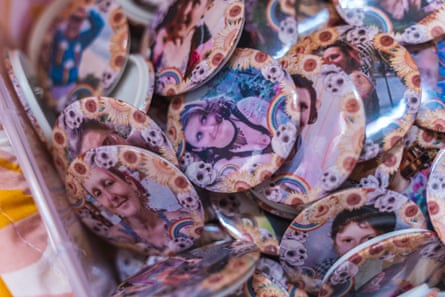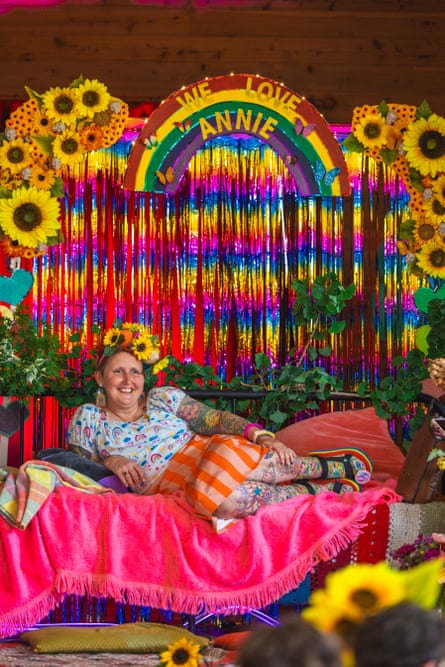Annie Werner, 45, lives on the far south coast of New South Wales, just out of Bega. Five years ago she was diagnosed with terminal breast cancer. Six months ago, it metastasised to her liver and bones, and she decided to plan a celebration of her life on her own terms, held last weekend. This interview has been edited and condensed for clarity.
The timeline of my death has been quite abstract but about six months ago we found out the treatment I had previously been on was not working at all any more, that the cancer had spread quite aggressively and quickly to my spine. I was like, OK, things are getting serious now.
For a couple of years I’ve been working with Sarah Barry, a death doula or mortality doula. My relationship with her is incredible. We talk a lot about what I want for my funeral and the end of my life, and it’s perfectly open and clear – I can ask and tell her anything. She’s very real with me. She’s not weird about death and her approach really sets the tone. With her, I can go wherever I want to go. We had talked about living wakes but it was quite an abstract concept for me personally – I don’t know anyone close who’s really had one. But I’m a Leo. I realised I didn’t want people saying super nice things about me after I’ve died – I want to be there for that!
I’ve had a pretty good life and I wanted to celebrate it: be with all the people who’ve been very special in it. And not after I’ve died. It just seemed weird for everyone to get together then. If I knew I was going to die anyway, why not get together beforehand and have a beautiful party?
It was a very collective experience. My life is very community-based: activism, working in different collectives and cooperatives – that’s how I’ve lived most of my adult life, and it was really nice to have people from different parts of it … worlds that haven’t necessarily collided before. My first girlfriend was there, from when we were 16, as well as very new friends, people I’ve known for six months. One of my Instagram friends flew out from Canada – we’d never met in real life! Making the guest list was very intuitive: I just kind of went through my contacts going, “OK, what is my feeling about this person? How have they contributed to my life? Do I want to gather with them in collective grief, and joy, and love?”
On the invitation I just said: come with an open mind and open heart, ready to celebrate me. A lot of people were genuinely confused and didn’t know what to expect. But most I’ve spoken to, especially those who were a bit apprehensive, have said how expansive it was for them. It was so joyful – equal amounts laughing to crying. So many people came up to me and were like, “Oh my God, thank you so much for having this – it’s a gift, to be able to celebrate you in this way.”
Because it’s not a very common thing to do, I felt very free to be my true self – really wild and free to do whatever I wanted. I’ve joked that I was a “wakezilla”: I had my little group of friends organising it for me, the Ultimate Committee. (That’s my favourite name for the gathering: Annie’s Ultimate Celebration.) Every idea I had, they just put it into action. It was all decorated when I got there – like, what the hell? People brought my favourite foods: fairy bread and party pies and jelly and cupcakes. One friend did a mocktail bar. Another did the merch table. I had some memory books people could write or stick things in.

I also had a coffin decorating station. So I had my coffin there; it’s a cardboard one. I bought heaps of different paints and textas and things to stick on, and people could write and draw and do whatever they wanted on that. It looks incredible now. When I first saw it, I was like, “Oh, hi coffin.” But six months ago, I cared for my nana as she died. We were very close and engaging with her body and coffin was actually a really special and very transformative process; we tucked in lots of photos and different artefacts and letters from her life, all in around her.
I understand that for some people seeing a coffin is really confronting and they might not want to do that, so I didn’t want mine to be in the main space of the party – I really didn’t want anyone to feel like they’re being pressured into facing something that they weren’t ready to face. So it was off to the side, in a little covered balcony area. People could take the time to go there if they wanted, or not, if they didn’t.
Both my sons were there; they’re 17 and 13. I had said to them beforehand, “This is what’s going to happen at my party: my coffin is going to be there and you don’t have to see it if you don’t want to.” But they both engaged with it. I think normalising those kind of processes in a joyful way makes it easier to face death and to grieve.

When I gave my speech, my eldest son was sitting next to me and he was just crying. He was so present with his emotions, in front of everyone – openly crying and interjecting to make hilarious gags. It was pretty amazing, being with him in that space. I was so proud of my kids and the way they responded to everything.
The party went for five hours. We got there at 2pm and there was welcoming and people made little name tags that said, “Hi, my name is whatever, and my favourite thing about Annie is whatever.” (Another one of my wakezilla requests.) People had drinks from the bar and settled in, and were talking to everyone. Then Sarah – who was like the celebrant, she officiated everything – started the ceremony: speeches and songs and poems. Everyone sang along, like a karaoke singalong, to Let It Go from Frozen, which is one of my favourite songs. Then there was an open mic, where people could come up if they felt compelled to share something. There were lots of stories from different periods of my life, stories about how I’d impacted people … so that’s pretty amazing and nice.

It was at a tiny little community hall and up on stage there was a bed and sort of altar my friends had made, where I sat for most of the proceedings: we called it my throne altar. Because I’m in a lot of pain and don’t have heaps of energy, I knew I needed a space where I could just lie down and people could just come up on to the stage and sit with me or whatever.
My friend, who lives up Wollongong, wrote a song about me. I don’t even know how they managed this but they made a little choir with people from down here. So they were singing together for the first time, this song about me. The sunlight was coming through the window in a really beautiful way, right when they were singing. That was amazing.
Every single minute was just so special and so incredible. Surprising and beautiful.
Obviously it’s upsetting. It’s not like, yay, I have terminal cancer. But I think I have a different relationship to it than a lot of people. Basically I want to call the shots.
I was talking to my oncologist this week and telling her about my living wake, and she was like, “Oh my God, I wish more people would do that.” She says she has people who are literally going to die any day, in her office, begging her for more treatment. I definitely don’t want to be like that. I’m like, yeah, I’m going to die. Let’s grab that – not “make the most of it” but have a relationship with that process. My advice is to just make it your own thing. Just do whatever you want to do. Be a wakezilla. And every kind of crazy idea that you have, just try to make it happen.
I genuinely believe our cultural relationship to death and dying is not healthy and so I was interested in interrogating that and changing it. Having my living wake was really a practical way of being like, “Hey, we can do this differently. Let’s see what we can do with this thing that we all have to go through – that’s not like this terrible, scary, hidden kind of thing. Let’s make it something else.”
Credit: Source link




